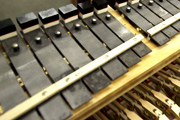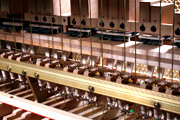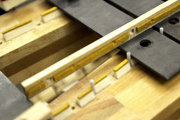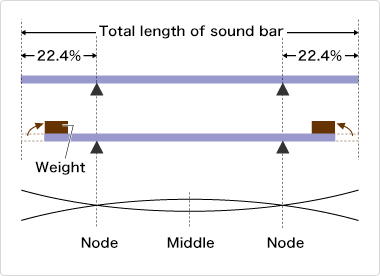The Structure of the Celesta
Celesta sound bars are lined up in rows-like a metallophone
The rule of sound bars: Thickness and length
Celesta sound bars are lined up in rows, like in a metallophone. The shorter a sound bar is, the higher its pitch is. This means that as you go up in pitch the sound bars become shorter. The thickness also varies. Sound bars with a low pitch are around 2 mm thick, while those with a high pitch are around 2.5 mm.
With two sound bars of the same size, the thicker bar will have a higher pitch. For example, consider a sound bar with the pitch of C that is 2 mm thick. If its length is kept the same but it made 3 mm thick, its pitch will increase from C to around E. If you want a 3 mm thick bar to have the pitch of C, you will need to lengthen it. In other words, if you want to make a sound bar thicker but retain the same pitch, you also need to make it longer.
Increasing the thickness of a sound bar also gives it a more metallic timbre. For example, a Yamaha celesta has sound bars that are around 2 to 2.5 mm thick, while a metallophone (in which the sound bars are struck by mallets) has sound bars that are around 7.8 to 9 mm thick. The thicker a sound bar is, the longer it will be. It will also have a more metallic reverberation.

A row of sound bars beneath resonator boxes

Lower action mechanism when a black key is pressed
Why are there holes in the sound bars?
The holes in the bars are used to keep them in place. A hole is drilled into the vibration node, then the sound bar is placed on top of a felt pad and screwed in place. If the node is fixed too tightly in place it will stop the sound from reverberating, so there is some skill involved in making sure the sound bar stays in place while still allowing it to reverberate. There are two nodes on every sound bar, located at either end at a position 22.4% of the total length of the sound bar.

Felt is installed below and above the sound bars
Bass weights are used to adjust the pitch
Weights are attached to both ends of bass register sound bars. These weights ensure that that the volume from each node to each end is the same, and are a clever way to shorten the sound bars without changing their pitches. The lower the pitch of a sound bar, the longer it will be. If these weights were not used the instrument itself would become far too deep. In other words, weights are used to adjust the pitch of the sound bars so that the instrument can remain compact. Weights and the thickness of the sound bars are therefore both related to the size of the instrument.

The sound bar on the right is for the bass register. You can see the weights attached to either end.

